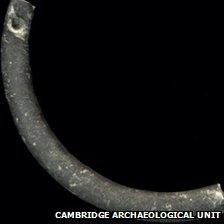'Bronze Age' artefacts found at Anglesey Abbey
- Published

A fragment of a shale bracelet discovered at Anglesey Abbey
"Potentially Bronze Age" artefacts found at Anglesey Abbey could prove the site was occupied up to 2,000 years earlier than had been thought.
The discoveries were made during work to build a new car park at the National Trust property near Cambridge.
Cambridge Archaeological Unit said the site, containing possible roundhouses, a granary, pottery and a shale bracelet fragment, could have been a farmstead.
It was previously thought the area was occupied from the early 12th Century.
The features uncovered are believed to date from the late Bronze Age to the middle Iron Age (1000BC to 100BC).
They include possible storage pits which contained pottery, animal bones, and burnt stones which were thought to have been used for cooking food.
Before the excavation, historians believed occupation of the site could only be traced as far back as the early 1100s when Henry I had a hospital built there.
Analysis of the findings is being carried out by the archaeology unit, which is part of Cambridge University.
It is hoped the artefacts will eventually be put on public display at Anglesey Abbey.
- Published9 December 2011